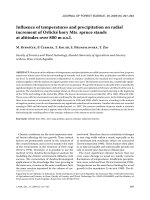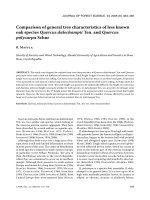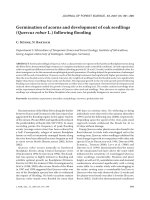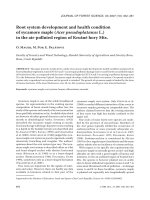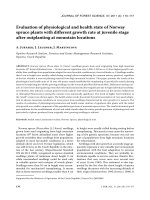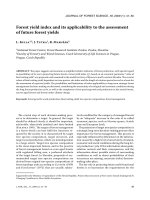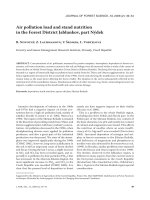Báo cáo lâm nghiệp: " Compatible stem taper and stem volume functions for oak (Quercus robur L and Q petraea (Matt) Liebl) in Denmark" docx
Bạn đang xem bản rút gọn của tài liệu. Xem và tải ngay bản đầy đủ của tài liệu tại đây (742.67 KB, 18 trang )
Original
article
Compatible
stem
taper
and
stem
volume
functions
for
oak
(Quercus
robur
L and Q
petraea
(Matt)
Liebl)
in
Denmark
MJ
Tarp-Johansen
JP
Skovsgaard
SF
Madsen
VK
Johannsen
I Skovgaard
2
1
Danish
Forest
and
Landscape
Research
Institute,
Department
of
Forestry,
Hørsholm
Kongevej
11,
DK-2970
Hørsholm;
2
Royal
Veterinary
and
Agricultural
University,
Department
of Mathematics
and
Physics,
Thorvaldsensvej
40,
DK-1871
Frederiksberg
C,
Denmark
(Received
5
April
1996;
accepted
17
March
1997)
Summary -
In
this
paper
we
develop
compatible
stem
taper
and
stem
volume
functions
for
oak
(Quercus
robur
L and Q
petraea
(Matt)
Liebl)
in
Denmark.
In
the
compatible
system
of
stem
taper
and
volume
functions
the
solid
of
revolution
of
the
stem
taper
equation
equals
the
volume
according
to
the
total
stem
volume
function.
The
stem
volume
is
explicitly
expressed
in
the
stem
taper
function.
Thus,
it
is
possible
to
adjust
estimates
of
the
stem
taper
curve
to
a
specific
stand
volume
level
(and
thereby
accounting
for
the
effect
of
silvicultural
practice
on
stem
taper).
The
accuracy
of
predictions
from
the
stem
volume
function
for
oak
is
comparable
to
similar
functions
for
three
broadleaved
species
and
six
conifers.
Comparable
stem
taper
functions
for
other
broadleaved
species
are
not
available,
but
compared
to
conifers
the
stem
taper
function
for
oak
performs
relatively
well
considering
the
substantial
number
of
forked
oak
trees.
stem
taper
/
stem
volume
/
oak
/
Quercus
robur
/
Quercus
petraea
Résumé -
Système
compatible
d’équations
de
défilement
et
de
tarif
de
cubage
pour
les
chênes
au
Danemark.
Dans
cet
article,
nous
développons
des
équations
de
défilement
et
des
tarifs
de
cubage
compatibles
pour
les
chênes
(Quercus
robur
L
et
Q
petraea
(Matt)
Liebl)
au
Danemark.
Dans
ce
système
cohérent,
le
solide
de
révolution
engendré
par
l’équation
de
défilement
a
le
même
volume
que
celui
fourni
par
le
tarif
de
cubage
de
la
tige.
Le
volume
du
tarif
de
cubage
est
exprimé
explicitement
à
partir
de
l’équation
de
défilement.
Ainsi,
il
est
possible
d’ajuster
les
estimateurs
de
la
forme
de
défilement
à
un
niveau
local
du
tarif
de
cubage
(et,
de
là,
prendre
en
compte
les
influences
* Correspondance
and
reprints
Tel:
(45)
45
76
32
00;
fax:
(45)
45 76 32 33;
e-mail:
des
pratiques
sylvicoles
dans
le
défilement
de
la
tige).
La
précision
des
prévisions
faites
à
partir
du
tarif
de
cubage
est
du
même
ordre
de
grandeur
que
des
fonctions
similaires
pour
trois
espèces
feuillues
et
six
de
conifères.
Des
équations
de
défilement
pour
d’autres
espèces
feuillues
ne
sont
pas
disponibles,
mais
comparé
au
résultat
pour
les
conifères,
l’ajustement
de
la
fonction
de
défilement
pour
les
chênes
est
satisfaisant,
étant
donné
notamment
le
nombre
élevé
de
chênes
fourchus.
défilement
/
volume
tige
/
chêne
/
Quercus
robur
/
Quercus
petraea
INTRODUCTION
Compatible
stem
taper
and
stem
volume
functions
for
commercial
tree
species
are
very
useful
and
flexible
tools
for
both
forestry
practice
and
forest
research.
These
functions
provide
estimates
of
stem
diam-
eter
at
any
height
and
estimates
of
total
stem
volume
as
well
as
merchantable
vol-
ume
at
any
stem
diameter
along
the
trunk.
Such
functions
may
be
used
on
their
own
or
in
combination
with
growth
models
to
sim-
ulate
the
distribution
of
tree
sizes
and
vol-
umes.
In
the
compatible
system
of
stem
taper
and
volume
functions,
the
solid
of
revolu-
tion
of
the
stem
taper
equation
equals
the
volume
according
to
the
total
stem
volume
function.
The
stem
volume
is
explicitly
ex-
pressed
in
the
stem
taper
function.
Thus,
it
is
possible
to
adjust
estimates
of
the
stem
taper
curve
to
a
specific
stand
volume
level
(and
thereby
accounting
for
the
effect
of
silvicultural
practice
on
stem
taper).
The
concept
of
compatibility
of
stem
taper
and
stem
volume
functions
is
prob-
ably
as
old
as
the
idea
of
modelling
these
proporties.
The
concept
seems
to
have
been
formally
introduced
by
Demaerschalk
(1972,
1973)
for
total
volume,
and
sub-
sequently
refined
by
Burkhart
(1977)
and
Clutter
(1980)
to
include
functions
for
merchantable
volume.
Compatible
sys-
tems
may
be
taper-based
or
volume-based
(Munro
and
Demaerschalk,
1974),
depend-
ing
on
which
function
is
derived
first.
In
this
paper
we
develop
compatible
stem
taper
and
stem
volume
functions
for
oak
(Quercus
robur
L and
Q
petraea
(Matt)
Liebl)
in
Denmark.
The
system
is
volume-based
and
the
approach
follows
the
model
concept
previously
developed
for
conifers
(Madsen,
1985,
1987;
Madsen
and
Heusèrr,
1993;
see
also
Goulding
and
Murray,
1976).
The
further
development,
compared
to
the
traditional
compatible
sys-
tem,
includes
two
refinements
(introduced
by
Madsen,
1985):
1)
additional
restric-
tions
on
the
stem
taper
model
in
order
to
improve
model
performance,
and
2)
vari-
ables
that
simultaneously
account
for
butt
swell
and
taper
in
the
uppermost
part
of
the
stem.
MATERIAL
The
material
comprises
1131
sample
trees
from
a
total
of
38
plots
in
long-term
experiments,
conducted
by
the
Danish
Forest
and
Landscape
Research
Institute.
Data
collection
took
place
between
1902
and
1977.
Geographically
the
plots
are
unevenly
distributed
(fig
1),
with
two
thirds
of
the
plots
located
on
the
island
of
Zealand.
Moreover,
one
particular
forest
district
(Bregentved)
is
represented
by
314
trees
or
ap-
proximately
28%
of
the
material,
and
one
par-
ticular
plot
(sample
plot
QA,
Stenderup)
con-
tributes
as
many
as
90
trees.
Unfortunately,
the
data
include
only
one
’genuine’
thinning
expe-
riment
(thinning
grades
B,
C
and
D)
and
only
for
a
very
narrow
range
of
ages
(21-27
years).
Summary
statistics
are
given
in
table
I.
Stands
are
thinned
from
below,
and
most
sample
trees
chosen
among
thinned
trees.
Trees
were
sampled
to
represent
the
variation,
but
in
young
stands
with
a
tendency
to
favour
’average’
crop
trees.
Figure
2
shows
the
quadratic
mean
di-
ameter
and
the
diameter
range
of
sample
trees
compared
to
the
mean
and
range
of
remaining
trees.
The
figure
illustrates
that,
with
in-
creasing
age,
the
size
of
the
sample
trees
de-
creases
relative
to
the
size
of
the
remaining
crop
trees,
reflecting
the
combination
of thinning
and
sampling
practices.
A
total
of 215
sample
trees
(19%)
were
forked,
mostly
with
the
fork
base
being
located
at
a
height
between
one
and
two
thirds
of
the
tree
height.
Further
details
have
been
reported
in
a
previous
paper
on
functions
for
total
tree
volume
(Madsen,
1987).
All
sample
trees
were
felled
and
the
logs
measured
according
to
the
so-called
relative
method
(Oppermann
and
Prytz,
1892;
see
also
Madsen,
1987).
With
this
method,
the
log
is
divided
into
two
main
sections,
one
above
and
one
below
1.30
m
above
ground
level.
The
sec-
tion
above
is
subdivided
into
ten
subsections
of
equal
length
(h -
1.30)/10,
hence
the
name
of
the
method.
The
section
below
1.30
m
is
subdi-
vided
into
four
subsections
of equal
length
(32.5
cm).
Subsections
above
1.30
m are
calipered
cross-wise
at the
end,
subsections
below
1.30
m
at
the
middle
(at
heights
0.16,
0.49,
0.81
and
1.14
m).
Stem
diameter
at
any
height
is
cal-
culated
as
the
average
of
the
two
perpendicular
measurements.
All
measurements
are
taken
out-
side
the
bark.
Above
1.30
m
subsection
volumes
are
cal-
culated
according
to
Smalian’s
formula,
below
1.30
m
according
to
Huber’s
formula.
Stem
di-
ameters
for
forked
trees
are
transformed
into
a
combined
diameter
measure
corresponding
to
the
joint
cross-sectional
area
of
the
forks.
To
minimize
bias
in
stem
taper
functions,
our
ex-
perience
suggests
that
the
diameter
at
0.16
m
height
be
set
equal
to
the
diameter
at 0.49
m.
Di-
ameter
at
the
tree
top
is
set
equal
to
zero.
Stump
height,
&jadnr;
s,
is
estimated
by
the
empirically
de-
rived
formula:
&jadnr;
s
=
0.12
+
d
1.30
/4
(Mad-
sen,
1987),
where
d
1.30
is
the
diameter
at
breast
height.
Thus,
’true’
stem
volume
is
calculated
as
where
v
is
total
stem
volume
excluding
stump,
&jadnr;
s
denotes
estimated
stump
height,
h
is
total
height
from
ground
to
tip
of
tree,
d
0.49
, d
0.81
,
d
1.14
and
d
1.30
are
the
diameters
at
a
height
of
0.49,
0.81,
1.14
and
1.30
m,
respectively,
and
d
0.1
,
d
0.2
, ,
d
0.9
are the
diameters
at the
rela-
tive
heights
n(h -
1.30)
+
1.30
for
n
=
0.1,
0.2,
,
0.9.
The
calculation
of
v in
cubic
me-
tres
implies
all
diameter
and
height
measures
to
be
inserted
in
equation
[1]
in
metres.
METHODS
Stem
volume
function
The
chosen
stem
volume
model
originates
from
the
classic
stem
taper
function
(Riniker,
1873;
see
for
example
Philip,
1994)
where
dl
designates
the
diameter
at
a
given
height
l
(above
ground),
h
is
the
total
tree
height,
and
the
numerical
constants
p
and
r
define
the
rate
of
taper
and
the
shape
of
the
solid,
respec-
tively
(p
>
0,
r
>
0);
r
is
called the
form
expo-
nent.
The
solid
of
revolution,
ie,
the
stem
vol-
ume,
is
thus
and
by
logarithmic
transformation
(base
e)
of
equation
[4],
a
linear
model
results:
By
adding
stand
parameters
to
allow
for
tem-
poral
changes
within
a
stand
(plot),
by
mak-
ing
proper
assumptions
about
ln(r
+
1)
and
r ·
ln(h/[h -
1.30])
(Madsen,
1987;
cf Kunze,
1881)
and
by
defining
a
level,
A,
specific
to
the
stand
(plot),
the
logarithmic
stem
volume
model
becomes
where
i
denotes
stand
(plot)
number; j
denotes
tree
number
(in
stand
i);
k
denotes
predictor
number;
Y
ij
=
ln(v
ij);
v
ij
is
the
stem
vol-
ume
(m
3)
of
tree
no
ij;
Ai
is
the
stand
(plot)
specific
level
(assumed
N(μ,
σ
2A)
and
mutually
independent);
bk
denotes
the
k’th
coefficient;
x
ijk
or
xk
in
abbreviated
notation,
denotes
the
k’th
predictor
variable
(full
list
in
Appendix
1),
where
in
particular:
x1
=
In(d1.30
),
x2
=
ln(h),
x4
=
ln(h/[h -
1.30]),
x
25
=
D2g;
Dg
is
the
quadratic
mean
diameter;
and
e
ij
denotes
the
error
term
(assumed
N(0,
σ
2c
),
mutually
in-
dependent
and
independent
of
A,).
In
total,
11
potential
predictor
variables
(listed
in
Appendix
1)
were
considered.
For
this
purpose,
unweighted
linear
least
squares
regression
were
used.
The
variables
were
tested
according
to
four
criteria:
1)
Variables
x1
and
x2
are
compulsory.
2)
Subset
models
with
a
varying
number
of pre-
dictors,
but
with
a
similar (low)
value
of Mal-
low’s
Cp,
are
selected
for
further
testing.
If
the
model
has
p
predictors,
including
the
in-
tercept,
then C
p
=
(k-p)(F-1)+p,
where
k
is
the
total
number
of
(candidate)
predictors
and
F
is
the
F-statistic
for
testing
the
model
in
question
against
the
model
including
all
k
predictors.
Mallow’s
Cp
combines
estimates
of
bias
and
variance
into
a
single
measure
of
prediction
error
for
the
model.
3)
The
selected
subset
models
are
compared
by
a
cross-validation
method
where
each
plot
is
systematically
omitted
in
the
parameter
estimation
(Andersen
et
al,
1982).
A
few
predictor
combinations
with
the
lowest
sum
of
squares
of
the
prediction
error
of
the
ex-
cluded
trees,
are
chosen
as
candidates
for the
final
model.
4)
The
final
choice
is
based
on
an
evaluation
of
model
behaviour,
with
due
reference
to
the
cross-validation
results.
For
example,
age
may
be
selected
as
a
final
predictor
accord-
ing
to
the
criteria
2
and
3,
but, in
combination
with
other
predictor
variables
and due
to
the
geographically
biased
origin
of
data,
its
in-
clusion
may
result
in
undesirable
model
be-
haviour.
The
mixed-effect
logarithmic
stem
volume
model
(eq
[6])
accounts
for
within-plot
corre-
lation.
The
mean
level,
μ,
the
coefficients,
bk,
and
the
inter-stand
and
single-tree
variances,
σ
2A
and
σ
2e,
respectively,
are
estimated
by
the
re-
stricted
maximum
likelihood
method,
using
the
Proc
Mixed
procedure
of
SAS.
By
reverse
transformation,
the
stem
volume
function
can
be
expressed
as
where
symbols
are as
above,
and
the
sample
variance
term
(s
2A
/2
+
s2e
/2)
corrects
the
bias
due
to
the
logarithmic
transformation.
We
refer
to
equation
[7]
as
the
general
stem
volume
func-
tion.
The
practical
application
of
the
stem
volume
function
for
a
given
stand,
, requires
a
pre-
diction
of
the
corresponding
adjusted
level,
A.
Based
on
trees
sampled
in
stand
for
this
pur-
pose,
the
adjusted
A-level
can
be
calculated
ac-
cording
to
the
following
procedure:
Define
and
suppose
that
the
’true’
stem
volumes
of n
sample
trees
in
stand
is
known.
Insertion
of
the
estimates,
&jadnr;
k,
yields
and
the
estimator
of
A
with
smallest
mean
square
error
is
(cf
Andersen,
1982)
where
is
based
on
the
sample
variances,
s2A
and
s2e,
for
inter-stand
and
single-tree
variation,
respe-
ctively,
&jadnr; denotes
estimated
mean
level,
and
n
is
number
of
trees
sampled
for
level
adjustment.
Using
equation
[10]
to
predict
the
stand
level
on
the
basis
of
n
trees
we
obtain
the
single
tree
volume
prediction
with
stand
level
adjustment
Compatible
stem
taper
function
Combining
the
classic
equations
[2]
and
[3]
yields
the
compatible
stem
taper
model
where
dl
designates
the
diameter
at
a
given
height
I
(above
ground),
h is
the
total
tree
height,
and
v
is
the
stem
volume.
For
integers
of
the
form
exponent,
r,
equa-
tion
[
13]
can
be
changed
to
a
polynomial
model
of
the
variable
(l/h).
To
allow
for
a
varying
form
exponent,
r, and
thus
improved
flexibility,
this
model
may
be
extended
to
the
stem
taper
function
(Madsen,
1985)
where
&jadnr;
l
denotes
the
predicted
diameter
I
m
above
ground,
&jadnr;
is
the
stem
volume
predicted
by
the
stem
volume
function
(eq [7]),
&jadnr;
i
are
coef-
ficients
(i
=
1, 2, ,
10),
&jadnr;
0.49
denotes
pre-
dicted
diameter
at
0.49
m
above
ground,
and
&jadnr;
s
is
estimated
stump
height
(&jadnr;
s
=
0.12
+
d
1.30/4).
Four
restrictions
are
imposed
on
equation
[14]:
1)
the
solid
of
revolution
for the
stem
taper
function
(eq
[14])
has
to
equal
the
volume
of
the
stem
volume
function
(eq
[7]);
4)
the
derivative
of
2l
with
respect
to
I
has
to
equal
zero
for
I
=
h.
Only
restriction
1
is
needed
to
provide
com-
patible
functions.
Restrictions
2-4
give
the
stem
taper
function
desirable
properties.
Restriction
4
ensures
a
smooth
taper
at
the
top.
Compati-
bility
may
be
achieved
in
two
different
ways:
through
taper
calculations
based
on
1)
stem
vol-
ume
estimates
by
the
volume
function
with
a
general
level
μ
(eq
[7]),
or
based
on
2)
stem
vol-
ume
estimates
adjusted
according
to
stand
con-
ditions
(eq
[8-10]).
Both
types
of compatible
ta-
per
functions
were
developed.
Incorporating
these
four
restrictions
into
equation
[14]
and
correspondingly
eliminating
four
bi
-coefficients
(Appendix
2),
ensures
that
the
restrictions
hold
exactly
for
each
tree.
This
results
in
the
model
where
the
a-coefficients
are
summarized
in
Ap-
pendix
3.
In
generalized
notation
this
becomes
The
response
variable
yl
can
be
expressed
as
a
function
&phis;(d
2l,
&jadnr;,
&jadnr;
s
, h,
l/h),
and
x
il
as
a
func-
tion ψ
s
(&jadnr;
s
, l/h).
The
’fixed’
coefficients
b1
-
b3
and
b8
-
b
10
are
estimated
for the
material
as
a
whole,
us-
ing
linear
least
squares.
Thus,
the
’fixed’
coeffi-
cients
remain
constant
across
trees
of
the
same
species
within
the
region.
The
number
of
’fixed’
coefficients
may
be
reduced,
if
convenient,
for
the
species
under
consideration
(Madsen,
1985).
The
’variable’
coefficients
b4
-
b7
are
calcu-
lated
seperately
for
each
tree,
in
contrast
to
the
’fixed’
coefficients,
as
(cf Appendix
2).
Then,
based
on
&jadnr;
1
- &jadnr;
10
, &jadnr;, h and &jadnr;
0.49
,
stem
taper
is
determined
by
equation
[14].
By
integrating
equation
[14],
an
expression
for
merchantable
stem
volume
with
varying
mer-
chantable
limit,
a,
can
be
deduced
(Madsen,
1985) as
where
&jadnr;
a
is
predicted
merchantable
stem
vol-
ume,
I
denotes
the
height
above
ground
where
the
merchantable
limit
α
occurs,
and
other
sym-
bols
are
as
previously
described.
The
height
l
corresponding
to
a
given
merchantable
limit
may
be
calculated
using
an
iterative
procedure
(Madsen,
1985).
RESULTS
Stem
volume
function
For
the
stem
volume
function
the
selec-
tion
procedure
indicated
4-5
variables
to
be
the
optimal
number;
no
improvement
of
Cp
or
the
cross-validation
results
occurred
by
including
more
variables.
In
addition
to
the
two
compulsory
predictors,
all
rel-
evant
combinations
of
x-variables
included
x4
(= ln(h/[h -
1.30])),
whereas
stand
height,
Hg,
only
appeared
in
inferior
subset
models.
To
account
for
temporal
changes
in
stand
conditions,
a
fourth
and/or
a
fifth
variable,
therefore,
had
to
include
stand
di-
ameter,
Dg,
or
stand
age,
T.
For
oak,
subset
models
including
T
performed
well.
This
may
be
attributed
to
the
uneven
geo-
graphical
distribution
of
plots.
For
most
other
species,
T
seems
to
be
a
predictor
of
dubious
quality
(Madsen,
1987),
except
for
Norway
spruce
(Madsen
and
Heusèrr,
1993).
Based
on
these
results,
terms
with
T
were
excluded.
The
final
model
includes
x1, x2,
x4
and
x
25
as
predictor
variables
(table
II).
Note
that
the
stem
volume
function,
provided
constant h
and
Dg,
has
the
desirable
prop-
erty
that
the
stem
form
factor
decreases
with
increasing
diameter
at
breast
height
(ie,
&jadnr;
1
<
2).
Stem
taper
function
Preliminary
calculations
revealed
that
one
particular
plot
(sample
plot
RA,
Esrum)
in-
troduces
a
severe
bias
in
the
stem
taper
function.
This
may
be
attributed
to
two
factors:
1)
trees
from
this
plot
are
by
far
the
smallest
(the
plot
is
represented
by
only
one
measurement
occasion;
Dg
=
2.4
cm,
Hg
=
3.6
m),
and
2)
rounding
diameter
measurements
to
the
nearest
even
millime-
tre
reduces
precision
compared
to
the
rest
of
the
material.
When
this
plot
is
omitted
the
results
improve
considerably,
and
it
is
thus
left
out
in
the
estimation
procedure
for
the
stem
taper
function.
Results
are
given
in
table III,
both
for the
general
level
function
and
for
the
adjusted
level
function.
Owing
to
restriction
1
for
equation
[14]
the
stem
taper
function
has
the
same
desirable
property
as
the
stem
vol-
ume
function
that,
provided
constant
h and
Dg,
the
stem
form
factor
decreases
with
in-
creasing
diameter
at
breast
height.
DISCUSSION
OF
SPECIFIC
RESULTS
Stem
volume
function
Model
assumptions
for
the
stem
volume
function
include
parallel
response
planes
whose
position
is
determined
by
stand-
specific
levels,
ie,
levels
that
are
specific
to
site
as
well
as
to
thinning
treatment.
An
F-test
revealed
a
significant,
but
rela-
tively
small
interaction
between
In(d1.30
)
and
stand
level
(A
in
eq
[6]).
Considering
the
need
for
a
function
easy
to
use
in
prac-
tice,
this
irregularity
was
ignored.
Unfortu-
nately,
the
material
leaves
no
real
opportun-
ities
to
test
a
possible
(expected)
pure
effect
of
thinning.
A
closer
examination
of
plots
with
an
almost
equal
proportion
of
forked
and
un-
forked
trees
revealed
that
the
stem
volume
of
forked
trees
is
underpredicted
compared
to
unforked
trees.
A
level
adjustment
for
forking
was
sufficient
to
account
for
the
differences,
but
inconvenient
to
handle
in
practice
and
therefore
not
included.
According
to
the
variance
components,
the
coefficient
of
variation
(CV)
for
trees
within
a
stand
is
7.0%
(s
2e
=
0.004919),
and
the
CV
for
stand
means
is
2.4%
(s
2A
=
0.000598).
For
prediction
of
single
tree
volume,
the
CV
is,
however,
somewhat
larger
than
7.0%
because
of
the
uncertainty
in
the
estimate
of
the
stand
level.
Using
the
stand
level
adjustment
(eq
[12])
when
predicting
single
tree
volumes,
the
relative
prediction
error
is
where n
is
the
number
of
trees
sampled
for
level
adjustment.
The
relative
prediction
error
for
the
sum
of
the
total
stem
volumes
of
a = 1,2, , m
trees
may
similarly
be
shown
to
be
where
&jadnr;
ia
denotes
the
predicted
stem
vol-
ume
of
the
individual
m
trees.
When
all
m
trees
are
of
equal
size,
rpe
assumes
a
minimum
value
for
any
given
number,
n,
of
sample
trees.
When
one
tree
is
much
larger
than
the
remaining
m -
1
very
small
trees,
rpe
converges
towards
its
maximum
value
(≈
rp
esigle
)
for
any
given
number
of
sam-
ple
trees.
The
coefficient
of
variation
for
predicted
stem
volumes
(CV(&jadnr;
) =
s&jadnr;
,/v
in
eq
[2 1 ])
increases
with
increasing
age
and
de-
creases
with
increasing
thinning
grade.
For
oak
on
sites
such
as
those
included
in
this
study,
CV(&jadnr;
)
typically
ranges
from
10%
in
heavily
thinned
stands
to
20%
in
lightly
thinned
stands
at
the
age
of
75
years.
In
heavily
thinned
stands
CV(&jadnr;
)
reaches
40%
at
the
age
of
150
years.
As
an
example,
let
CV(&jadnr;
)
<
50%,
50
<
m
<
2500,
and
5
< n
<
25.
Then
rpe
single
varies
be-
tween
7.1
and
7.3%,
and
rpe
between
1.2
and
2.2%.
Stem
taper
function
In
addition
to
the
properties
implied
by
model
restrictions
1-4,
the
stem
taper func-
tion
should
generally
predict
the
diminish-
ing
diameter
from
the
ground
to
the
top
of
the
tree,
and
should
not
predict
negative
values
of d
2l.
These
properties
were
examined
by
predictions
of
d2l
for
all
(d
1.30
,
h,
Dg
)-
combinations
occurring
in
the
material;
d2l
was
predicted
for
all
heights,
l,
at
which
were
measured.
The
computa-
tions
showed
no
cases
of
an
increasing
di-
ameter
by
increasing
height
above
ground,
after
exclusion
of
the
sample
plot
RA.
In
contrast,
for
426
trees,
measured
diameters
increased
with
height
in
one
or
more
parts
of
the
tree.
For
272
of
these
trees,
the
in-
crease
in
diameter
was
either
very
small
(≤
1
mm)
or
due
to
forking
(the
procedure
for
calculating
a
joint
sectional
area
will
of-
ten
cause
increasing
diameters
around
the
point
of forking).
Different types
of irregu-
larities,
such
as
wounds,
coarse
bark
areas
and
epicormic
branches,
may
be
respon-
sible
for
the
rest.
No
negative
predictions
of
d2l
were
observed.
The
performance
of
the
stem
taper
func-
tion
has
been
evaluated
in
terms
of
relative
deviations,
δ,
from
the
original
measure-
ments,
where
δ
=
100(d
l
-
&jadnr;
l
)/d
1.30
,
for
each
measurement
height
l.
Mean
values
appear
in
table
IV
and
figure
3.
The
stem
taper
function
generally
pre-
dicts
well
for
the
lower
and
economically
important
part
of
the
stem.
For
the
ma-
terial
as
a
whole
(table
IV),
mean
devia-
tions
are
positive
(ie,
predicted
diameter
too small) in
the
lower
one
third
of
the
stem,
and
negative
above.
For
forked
trees,
how-
ever,
mean
deviations
are
generally
positive
throughout,
consistent
with
stem
volume
(under)
predictions.
The
deviations
have
minimum
standard
deviations
near
breast
height
and
near
the
tree
top,
correspond-
ing
to
the
restrictions
forcing
the
stem
ta-
per
through
d
1.30
at
breast
height
and
zero
at
the
tree
top.
For
large
trees
(d
1.30
>
60
cm, h
>
20
m),
the
performance
of
the
stem
taper
func-
tion
deteriorates,
in
particular
for the
up-
per
and
economically
unimportant
part
of
the
stem
(fig
3).
The
adjustment
of
volume
level
generally
results
in
decreased
taper
deviations.
The
stem
taper
deviations
show
similar
patterns
for
the
general
level
and
adjusted
level
models.
This
indicates
that
the
pattern
is
a
charateristic
of
the
model,
rather
than
a
consequence
of
which
type
of
stem
volume
estimates
(adjusted
or
general
level)
the
stem
taper
function
is
based
on.
GENERAL
DISCUSSION
The
general
discussion
focuses
on
four
iss-
ues:
Material,
Methods,
Results
in
relation
to
previous
work
and
Application
in
prac-
tice.
Material
The
material
covers
a
considerable
range
of
individual
tree
sizes
and
stand
conditions,
indicating
good
representation.
However,
the
data,
and
thus
the
volume
and
stem
ta-
per
functions,
are
subject
to
four
limita-
tions.
First,
the
uneven
geographical
distribu-
tion
of
plots
implies
that
the
functions
have
not
been
verified
for
trees
growing
un-
der
poor
conditions,
ie,
notably
plantations
on
sandy
soils
in
Jutland.
Second,
only
thinned
trees
were
sampled,
and
by
subjec-
tive
procedures.
In
consequence,
the
func-
tions
may
not
represent
well
the
extremes
in
young
stands
and
large
crop
trees
in
old
stands.
Furthermore,
temporal
and
per-
sonal
differences
in
sampling
procedures
may
have
affected
the
inter-stand
variation.
Third,
the
trees
were
sampled
over
a
long
period
of
time,
and
may
represent
other
than
current
thinning
practices.
Fourth,
the
use
of
the
relative
method
limits
procedures
for
stem
volume
calculations.
This
intro-
duces
a
bias
in
the
volume
function
be-
cause
the
’true’
stem
volume
(eq
[1])
as
calculated
in
this
paper,
results
in
an
over-
estimation
of
approximately
0.4%
(Mad-
sen,
1985,
1987).
On
the
other
hand,
d
1.30
and h
are
easy
to
measure
in
practice.
Methods
A
problem
with
an
analysis
of
this
kind
is
that
trees
within
a
stand
are
not
statis-
tically
independent.
This
is
reflected
by
the
choice
of
cross-validation
method
in
the
selection
procedure
for
predictor
variables.
An
entire
stand
was
omitted
in
each
step,
thus
leading
to
fairly
realistic
prediction
er-
rors
on
which
the
selection
is
based.
For
practical
reasons
an
initial
selection
was,
however,
based
on
Mallow’s
Cp
which,
by
its
construction,
behaves
much
like
a
cross-validation
with
single
tree
omissions.
This
method
favours
models
with
too
many
stand
variables,
but
was
considered
suffi-
ciently
reliable
for
a
preliminary
selection.
Another
problem
is
that
diameter
mea-
surements
along
a
single
stem
may
be
cor-
related.
This
is
indirectly
accounted
for
by
the
use
of
smooth
functions
in
the
stem
taper
model
(eq
[14]),
and
by
the
use
of
tree
volume
as a
covariate.
Alternatively,
within-tree
correlations
may
be
modelled
directly
(see
for
example
Gregoire
and
Schabenberger,
1996),
in
which
case
re-
strictions
3
and
4
should
be
abandoned.
Results
in
relation
to
previous
work
The
accuracy
of
predictions
from
the
stem
volume
function
for
oak
is
comparable
to
similar
functions
for
three
broadleaved
species
(Madsen,
1987)
and
six
conifers
(Madsen,
1987;
Madsen
and
Heusèrr,
1993).
The
lack of parallel
response
planes
and
a
potential
systematic
effect
of
forked
trees,
also
agree
with
previous
results.
Comparable
stem
taper
functions
for
other
broadleaved
species
are
not
available,
but
compared
to
conifers
(Madsen,
1985;
Madsen
and
Heusèrr,
1993)
the
stem
taper
function
for
oak
performs
relatively
well.
For
conifers,
mean
deviations
are
generally
below
1%,
the
few
forks
being
excluded.
Mean
deviations
ranging
up
to
3.3%
for
oak,
where
the
number
of forked
trees
were
substantial,
is
therefore
a
satisfactory
re-
sult.
Application
in
practice
Being
based
on
stem
form
consider-
ations
as
well
as
easily
measurable
tree
variables,
both
the
stem
volume
and
the
stem
taper
models
are
accessible
and
easy
to
use
in
practice.
Worked
examples
to
help
users
check
their
implementation
of
the
functions
are
given
in
Appendix
4 (table
VI).
A
consequence
of
the
model
concept
is
that
bias
in
the
stem
volume
function
will
be
transferred
directly
to
the
stem
ta-
per
function.
By
choice
of
adequate
vol-
ume function,
this
weakness
is
of minor im-
portance
and
is
for
practical
purposes
out-
weighed
by
the
advantages
of
compatibil-
ity.
For
a
more
detailed
discussion
of
the
model
concept,
see
Madsen
(1985,
1987).
For
applications
in
science
and
in
prac-
tice,
it
is
a
particularly
important
feature
that
the
stand
specific
level
Ai
is
oper-
ational.
This
considerably
increases
the
applicability
of
the
functions
for
use
in,
for
example,
growth
modelling
and
forest
management.
For
forest
management,
the
information
from
the
stem
taper
function
on
log
mid-diameters
is
very
valuable.
REFERENCES
Andersen
S
(1982)
Combination
of
information
on
the
volume
level
of
a
stand.
Det forstlige
Forsøgsvœsen
i
Danmark
28,
87-82
Andersen
S,
Madsen
SF,
Rudemo
M
(1982)
Exam-
ination
and
comparison
of
tree-volume
functions
by
cross-validation.
Det forstlige
Forsøgsvœsen
i Dan-
mark
28,
275-285
Burkhart
HE
(1977)
Cubic-foot
volume
of
loblolly
pine
to
any
merchantable
top
limit.
Southern
J Appl
For
1, 7-9
Clutter
JL
(1980)
Development
of
taper
functions
from
variable-top
merchantable
volume
equations.
For
Sci
26,
117-120
Demaerschalk
JP
(1972)
Converting
volume
equa-
tions
to
compatible
taper
equations.
For Sci
18, 241-
245
Demaerschalk
JP (1973)
Integrated
systems
for the
es-
timation
of
tree
taper
and
volume.
Can
J For
Res
3,
90-94
Goulding
CJ,
Murray
JC
(1976)
Polynomial
taper
equations
that
are
compatible
with
tree
volume
equations.
NZ
J
For
Sci
5,
313-322
Gregoire
TG,
Schabenberger
O
(1996)
Nonlinear
mixed-effect
modeling
of
cumulative
bole
volume
with
spatially
correlated
within-tree
data.
J
Agric
Biol Environ
Stat
1,
107-119
Kunze
M
(1881)
Die
Formzahlen
der
gemeinen
Kiefer.
Supplemente
zum
Tharander
Forstlichen
Jahrbuche
2,
1-52
Madsen
SF
(1985)
Overensstemmende
stammeside-
og
vedmassefunktioner
for
fem
forskellige
nåletræarter
(Eng
summary:
Compatible
tree
taper
and
volume
functions
for
five
different
conifers).
Det forstlige
Forsøgsvæsen
i
Danmark
40,
97-140
Madsen
SF
(1987)
Vedmassefunktioner
ved
forskel-
lige
aflægningsgrænser
og
nøjagtighedskrav
for
nogle
vigtige
danske
skovtræarter
(Eng
summary:
Volume
equations
for
some
important
Danish
forest
tree
species.
Standard
and
form
class
equations.
Total
and
merchantable
volumes).
Det
forstlige
Forsøgsvœsen
i
Danmark
41, 47-242
Madsen
SF,
Heusèrr
M
(1993)
Volume
and
stem-taper
functions
for
Norway
spruce
in
Denmark.
Forest &
Landscape
Res
1,
51-78
Munro
DD,
Demaerschalk
JP
(1974)
Taper-based
ver-
sus
volume-based
compatible
estimating
systems.
For
Chron
50,
197-199
Oppermann
A,
Prytz
CV
(1892)
Undersøgelser
over
Rødgranens
Vækst
i
Danmark.
Det
Hoffenbergske
Etabl,
Kjøbenhavn
Philip
MS
(1994)
Measuring
Trees
and
Forests.
CAB
International,
2nd
ed
Riniker
H
(1873)
Ueber
Baumform
und
Bestandes-
masse.
Verlag
Sauerländer,
Aarau
APPENDIX
1
The
x-variables
considered
for the
stem
volume
function
are:
The
x-variables
x
10-x23
(Madsen,
1987)
are
for
merchantable
volume
functions
and
volume
functions
including
diameter
at
3
or
6
m
above
ground.
Therefore,
they
are
not
taken
into
con-
sideration
in
this
paper.
APPENDIX
2
Incorporating
the four
restrictions
imposed
on
the
stem
taper
function
(cf
Madsen,
1985).
Symbols
are
as
explained
in
the
main
text.
Given
the
stem
taper
function
(equation
[ 14]
in
the
main
text)
the
total
stem
volume
excluding
stump
(ie,
the
stem
volume
between
heights
&jadnr;
s
and
h)
is
where
i =
1, 2,
4, 5, 6,
7,
8, 9, 10
in
equation
[A2b].
Defining
a1
-a10
as
the
four
restrictions
may
be
expressed
as
fol-
lows:
1)
the
compatibility
restriction:
2)
the
restriction
on
top
diameter:
3)
the
restriction
on
breast
height
diameter:
4)
the
derivative
restriction:
Using
equations
[A4-A7],
four
b-coefficients
may
be
eliminated
in
the
stem
taper
function
(eq
[A1]).
This
will
ensure
that
the
four
restrictions
hold
exactly
for
each
tree.
Using
equation
[A5]
to
eliminate
b4
in
equa-
tions
[A4]
and
[A6]
yields
where
i
=
1, 2,
3,
5,
6, 7, 8, 9, 10.
Using
equation
[A10]
to
eliminate
b5
in
equations
[A8]
and
[A9]
yields
and
respectively,
where
i
=
1,
2,
3,
6,
7,
8,
9, 10.
To
eliminate
b6,
define
and
Then
equation
[A11]
may
be
expressed
as
and ([A12]) as
where
i =
1, 2, 3, 6, 7, 8, 9, 10.
Using
[A
15]
to
eliminate
b6
in
equation
[A
16]
yields
where
i
=
1, 2, 3, 7, 8, 9, 10.
To
eliminate
b7,
define
and
Then
[A
17]
may
be
expressed
as
Next,
define
and
Inserting
equation
[A20]
into
equation
[A15]
yields
To
eliminate
b5,
define
and
Inserting
equations
[A20]
and
[A23]
into
equa-
tion [A10]
yields
To
eliminate
b4,
define
and
Inserting
equations
[A20],
[A23]
and
[A26]
into
equation
[A5]
yields
Now,
the
a-coefficients
are
defined
and
the
four
restrictions
imposed
on
the
stem
taper
func-
tion
are
expressed
through
equations
[A20],
[A23],
[A26]
and
[A29].
The
restrictions
are
now
expressed
in
the
form
of
b-coefficients
ready
to
be
eliminated
in
the
stem
taper
function
(eq
[A1]).
Inserting
equations
[A20],
[A23],
[A26]
and
[A29]
into
equation
[A1]
yields
For the
least
squares
estimation
procedure
equa-
tion
[A30] leads
to
equation
[15]
in
the
main
text.
APPENDIX
3
The
a-coefficients
of
the
stem
taper
function
are:

